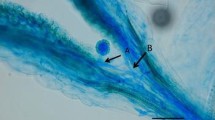Summary
In Brussels sprouts and Savoy cabbage the sporophytic incompatibility barrier can be broken by applying a direct electric potential difference of 100 V between pollen and stigma during pollination. The effect, measured as the number of seeds per flower, depends on the kind of plant and the degree of incompatibility. The mechanism underlying this phenomenon as well as the possible practical use of ‘electric aided pollination’ (EAP) are discussed.
Similar content being viewed by others
References
Braak, J. P., 1950. Bloembiologische waarnemingen bij kool (Brassica oleracea L.) en enkele verwante gewassen en de toepassing daarvan bij zaadteelt en veredeling. Jaarversl. Inst. Vered. Tuinb. Gewass. 1: 153–163.
Christ, B., 1959. Entwicklungsgeschichtliche und physiologische Untersuchungen über die Selbststerilität von Cardamine pratensis. Z. Bot. 47: 88–112.
Gonai, H. & Hinata, K., 1971. Effect of temperature on pistil growth and phenotypic expression of self-incompatibility in Brassica oleracea L. Jap. J. Breed. 21: 195–198.
Johnson, A. G., Adams, B. & Cotton, J., 1970. Practical studies on bud-pollination of Brussels Sprouts. Hort. Res. 10: 34–39.
Kroh, M., 1966. Reaction of pollen after transfer from one stigma to another (contribution to the character of the incompatibility mechanism in Cruciferae). Züchter 36: 185–189.
Linskens, H. F. & Kroh, M., 1967. Inkompatibilität der Phanerogamen. In: W., Ruhland (Hrsg.), Handbuch der Pflanzenphysiologie, Bd. 18: 506–530. Springer, Berlin-Heidelberg-New York.
Mc William, J. R., 1959. Bioelectrical phenomena in relation to pollination in Pinus. Silvae genet. Frankfurt 8: 59–61.
Nakanishii, T., Esashi, Y., & Hinata, K., 1969. Control of selfincompatibility by CO2 gas in Brassica. Pl. Cell Physiol. 10: 925–927.
Roggen, H. P. J. R., 1972. Scanning electron microscopical observations on compatible and incompatible pollen-stigma interactions in Brassica. Euphytica 21: 1–10.
Stout, A. B., 1931. Pollen tube growth in Brassica pekinensis. Am. J. Bot. 18: 686–695.
Tatebe, T., 1968. Studies on the physiological mechanism of selfincompatibility in Japanese radish. II. Breakdown of selfincompatibility by chemical treatments. J. Jap. Soc. hort. Sci. 37: 227–230.
Wiering, D., 1958. Artificial pollination of cabbage plants. Euphytica 7: 223–227.
Author information
Authors and Affiliations
Rights and permissions
About this article
Cite this article
Roggen, H.P.J.R., van Dijk, A.J. & Dorsman, C. ‘Electric aided’ pollination: A method of breaking incompatibility in Brassica oleracea L.. Euphytica 21, 181–184 (1972). https://doi.org/10.1007/BF00036758
Received:
Issue Date:
DOI: https://doi.org/10.1007/BF00036758




